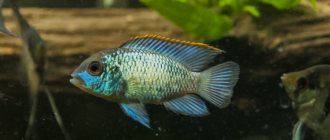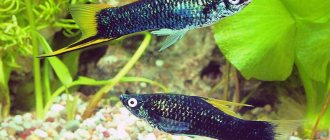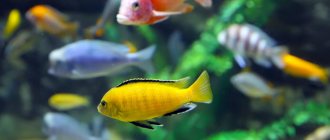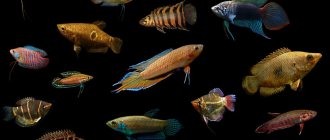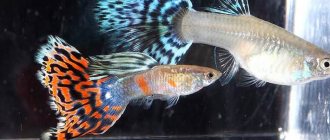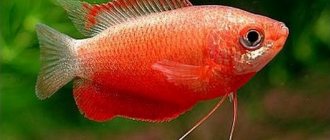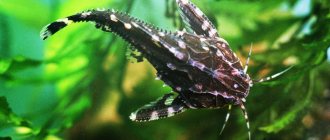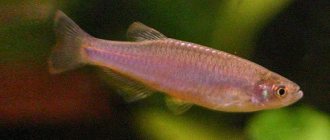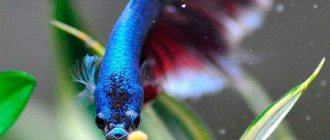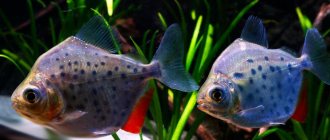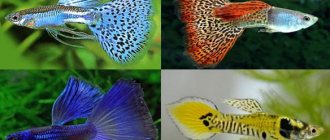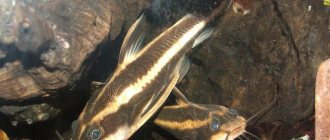Habitat of cancer – Ecuador, South America and northwestern Peru.
Family: cichlids or cichlids.
Water temperature: 22-26°C.
“Acidity”: Like most American cichlids, acara prefer a slightly acidic environment.
Acceptable Ph: 6.5-8.0 (for manufacturers 6.5-7.0);
Hardness dH: 6-13.
Behavior: Aggressive.
If you are in love with cichlids, if your heart is given to South America. Akara turquoise - your choice! The fish is amazingly beautiful, smart and obstinate! Because of her temper behind the hill, she was given the nickname - Green Terror - Green Terrorist. And it is true. Like all cichlids, Akara is characterized by aggression, territoriality, infighting and showdowns in little Tokyo.
But despite all this explosive mixture and the arrogance of the aggressor, Turquoise Akarych is a very, very popular guest of our aquariums. Besides, in our opinion, these Akaras of yours are not so evil. No better or worse than other large cichlids.
Compatibility of turquoise acara: For obvious reasons, it is best to plant neon, guppies and cockerels as neighbors to turquoise acara. They are tasty and crispy. Like chips with sour cream and onions! The Akaras will be very happy with such a neighborhood... the joy will quickly give way to loneliness. But that's it. But it was delicious.
If you still want more stable neighbors for cancer. Then pay attention to the same large cichlids of South America - Astronotus, Geophagus, large cichlids, etc.
We recommend watching our videos in which we perfectly visualized the hero of this article.
For those who don't understand humor. Turquoise akars are incompatible with any small and medium-sized fish. For more information, see the article: “Compatibility of aquarium fish.”
Description and characteristics
The Turquoise Acara is a popular cichlid kept in home aquariums. This is due to the fact that it is relatively unpretentious compared to other species, but the fish is very beautiful and is easy to get on sale.
Akara turquoise also known as Green Terror
Why is it called that?
The official name of this original fish is Andinoacara rivulatus. The fish belongs to the cichlid genus. Turquoise got its name due to the bright shiny scales that cover its entire body. Moreover, in the light, the acara scales shimmer with the most specific shades, which gives it incredible beauty and radiance. Aquarists love to place such fish in their aquarium, as they can be watched for hours.
Interesting fact!
The colloquial name for this fish is “Green Terrorist”. This is due to the bright shade of the fish and its aggressive nature.
Appearance and photo
Perhaps the bright and catchy appearance of this fish is the main thing that attracts aquarists to it. The entire surface of the acara in the photo is covered with turquoise scales, which have different shades.
The body itself has a silver-gray tint, with dark blue dots scattered throughout it, which change their color depending on the light. Because of this, the scales of the fish look as if they are glowing from within.
The size of the fish is large - it reaches from 20 to 30 cm. On the front of the fish there are wavy turquoise streaks. The back, rear and lower fins are shiny blue with white or yellow edging. A distinctive feature of males is a fatty growth on the forehead.
How to distinguish a female from a male
There are several differences between the male and female Acara turquoise:
- the male’s body shimmers with metallic blue and green, while the female has a darker tone;
- males are slightly larger than females and have a red stripe around the caudal fin, which females do not have;
- green anal fins in females and blue in males;
- Over time, males will develop a large rounded hump on their heads, but this will not happen in females;
- Females are more aggressive than males, especially during spawning.
What to feed
One of the most important questions is: what to feed the turquoise acara in the aquarium, since in nature this fish has the habits of a predator. Fish eat all kinds of insects, tiny fish, invertebrates, larvae, etc. But in general, this fish is not picky; it easily eats both ready-made live food and frozen and even fixed food. Some aquarists buy small, lean fish and shrimp specifically for their fish.
The main thing is that adults get enough protein food, because they are predators. As for dry food, you need to make sure that there is not too much of it, otherwise the water in the aquarium will quickly become clogged.
First a little history
Albert Karl Ludwig Gothelf Günther
(1830-1914) - a German zoologist, known to all aquarists for his work on the creation of an 8-year-old catalog of fishes (“Catalogue of fishes”), first gave a complete description of the turquoise acre back in 1860.
In the chapter dedicated to the “green terrorist”, he clearly attributed this fish to the cichlid family - Cichlidae, and said that the fish came to Europe from South America, where it lived freely in the rivers of Peru and Ecuador, preferring rocky-sandy areas, poorly penetrated by the sun shallow waters. Hiding under large rocks and dark driftwood, this iridescent aggressor attacked larvae, insects, small invertebrates and other smaller fish.
In his writings, Albert Gunther made no difference between the turquoise acre Andinoacara rivulatus and the blue-spotted acre Aequidens pulcher, classifying them as the same species.
For beginning fish farmers, these differences are so insignificant that it is not worth dwelling on them in detail.
It is worth emphasizing this detail: on the scale of aggression, the “blue horror” received as many as 80 points out of a possible 100, but cichlid lovers have found ways to tame such a tough temperament by choosing the right housing for the fish and the right neighbors for it.
Compatibility with other fish
One of the problems associated with keeping turquoise acara in an aquarium is its difficult compatibility with other fish. This applies not only to a specific species, but also to other fish from the cichlid genus. Therefore, neighbors for Akara are selected extremely carefully.
If you add tiny fish to an aquarium, the acara will accidentally eat them. If you choose similar large fish as neighbors, then there is a high probability that conflict and competition for territory will arise between them. However, most cichlids coexist amicably in the same aquarium with their pets. The main thing is that the volume of the aquarium allows this.
The fish very often exhibits increased aggression towards its neighbors in the aquarium.
Compatible
There are a number of fish with which the turquoise acara coexists quite calmly. These include:
- Cichlazoma severum santarem;
- Red parrot fish;
- Astronotus;
- Synodontis;
- Petrigoplicht;
All these fish coexist more or less calmly in the same aquarium with the turquoise acara. But it is worth considering that cyclazoma is very jealous of its territory, and in this case it is best to partition the space with the help of snags or decorative elements. The aquarium fish Astronotus can be added to the acara only if the volume of the aquarium allows. Both types of fish need a lot of free space. But Pterygoplich gets along well not only with Acaras, but also with any other cichlids.
Not compatible
Turquoise acara, like other types of cichlids, should not be placed in the same aquarium with small fish, including:
- Guppy;
- Angelfish;
- Barbs;
- Goldfish;
- Neons;
- Ampoules;
- Corridors.
The reasons for this are simple: a large acara can eat its tiny neighbors in the aquarium, since in their natural environment cichlids feed on similar types of fish.
Fact!
Small fish are not the optimal environment not only for turquoise cichlids, but also for other species of cichlids.
Relatively compatible species
Relatively compatible species include African cichlids. These fish are placed together in the same aquarium, but there are a number of differences. First of all, it's water. Under natural conditions, the turquoise acara lives in soft, quiet water, but African cichlids require mineralized alkaline water.
On average, African cichlids are slightly smaller in size than cichlids. However, in aquarium conditions, the size of both will be approximately 15 cm in length. But in general, adult individuals of these fish species do not conflict with each other and get along in the same aquarium.
It is dangerous to add small species of cichlids to acara
Feeding
The turquoise acara is unpretentious when it comes to food and loves to eat, therefore, like other representatives of the cichlid family, it is prone to obesity. Do not give in to the fish’s attempts to beg for food and feed it no more than 1-2 times a day.
Almost all types of live and artificial food can be used as food for these cichlids. The main thing is that the diet is varied and well balanced. You can offer your acara bloodworms, brine shrimp, tubifex, lean sea fish, mussels, shrimp and squid.
We should not forget about plant-based fertilizers. These can be cucumbers, zucchini, apples, scalded nettle and lettuce leaves, green peas.
But you shouldn’t overdo it with the meat of warm-blooded animals, since the fish body
is poorly absorbed and can often cause the development of hexamitosis.
Reproduction and breeding
Unlike many other aquarium fish species, breeding the Turquoise Acara is not difficult. Moreover, these fish often live and move in pairs. The most difficult thing is to find a mate for your fish.
Acara becomes sexually mature at about 8 months; until this moment, the fish often gather in schools, but after the onset of maturity they stay either in twos or alone. They choose their mate on their own, so finding a fish of the opposite sex will not be enough.
Spawning does not require any special conditions; this type of fish has a highly developed parental instinct, so breeding fish is possible even in an aquarium, if they are close to the natural conditions of existence of the acara.
Note!
The differences between males and females are striking: males are much larger, their color is brighter and more saturated, the color of females is darker. There is another significant difference: the fatty growth on the head of the male.
Requirements for the spawning tank
When fish are ready to spawn, some aquarists stimulate this process by increasing the water temperature. The main thing is that there is a stone or driftwood in the aquarium so that the female finds a suitable secluded place for spawning. Sometimes fish can dig a hole in the sand or soil.
Breeding procedure
The most difficult thing in the procedure of home breeding of turquoise acara is finding a suitable pair. After this, the male and female just need to be placed in the same aquarium, and spawning will happen by itself over some time, if, of course, the conditions in the aquarium meet the required ones. You won't have to put in any extra effort.
Both the eggs and the fry are cared for by both parents
Lifehacks by content
- Despite the evil nature of turquoise cancers, aquarists never tire of complimenting them. Pets are often praised for their bright appearance. Newbies complaining about the comparatively modest outfits of their favorite terrorists are advised to be patient. These fish do not bloom right away. Spawning has a big impact on appearance. As a rule, after the first, significant metamorphoses occur, turning young parents into bright handsome men.
- It affects coloring and feeding: the more varied and high-quality it is, the better the inhabitants of the aquarium look. But experts on the species advise not to rely too much on artificial food with additives to improve the quality of coloring.
- Amateurs also note the amazing intellectual abilities of turquoise cancers for fish. Very quickly they remember the owner, and when he approaches, they rush to the front wall of the aquarium in the hope of getting a treat or at least having fun watching a person.
- They are curious about other people, pets, and in general everything unusual that appears in sight. They enjoy looking at new items behind the glass, periodically straightening their dorsal fins to show who is the most important and beautiful here.
In good conditions, such fish live a long time: up to 10 years or even more. During this time, a strong bond is established between the pet and the owner. Terrorists become completely tame and literally start eating from a person’s hand. Some go even further and allow themselves to be stroked.
Previous
RybkiSeverum: intelligent handsome man with pretensions
Next
FishPseudotropheus elongatus. A unique species group with striking representatives
Diseases and prevention
Although this fish is quite unpretentious and resistant to a variety of unfavorable conditions, it still happens that the fish gets sick. If desired, the disease can be cured, the main thing is to notice it in a timely manner and take action. Below we will present the most common diseases in turquoise cancer.
Spironucleosis
This disease is associated with the fish's digestive system. It can be recognized by the secretion of mucus, as well as by poor digestion of food. At the same time, the cichlid begins to actively lose weight in the upper part, and the fish’s belly, on the contrary, swells. If ulcers appear on the head, then this is a sure sign of a late stage of development of spironucleosis.
To treat this disease, it is necessary to take baths with the addition of metronidazole every day. For the treatment to be effective, baths must be done for at least 12 days. After some time, it is advisable to repeat the course. You need to move the fish very carefully so as not to injure it.
Saprolegniosis
Spironucleosis is a fungal disease that manifests itself in the form of fairly large white spots throughout the body of the fish. With this disease, the rays of the tail and fins can stick together, and the scales peel off and bristle in all directions. Moreover, the fish’s body may even begin to bleed in particularly advanced cases of the disease. Treated with hour-long baths. Copper sulfate, manganese or streptocide must be added to the water. The fish is immersed in the resulting solution for about an hour. The procedure must be carried out periodically.
Attention!
It is important to be extremely careful, as any incorrect actions can only aggravate the problem. If experience and skills are not enough, it is best to consult an experienced aquarist.
Ascites
This disease does not rarely occur in turquoise cancer. It is characterized primarily by bulging eyes, significant bloating of the abdomen, and problems with the scales. This disease can be quite dangerous. Moreover, the fish can be cured only in the later stages of the disease.
If the owner notices mucous discharge in the fish’s stool, this is a sign that the disease is at a late stage. As a treatment, antibiotics are mixed into dry food for cichlids. Medicines must be prescribed by a doctor. Choosing antibiotics on your own can harm your fish.
If a sick individual is discovered, it is recommended to immediately isolate it
Price
As a rule, the cost of a fish directly depends on its size, age and other individual characteristics. On average, the cost of a turquoise akara starts from 200 rubles. An adult will cost much more - its cost can even reach several thousand rubles.
Also, those who are thinking about buying a turquoise acara should take into account that they will additionally need to purchase equipment, in particular, a spacious aquarium with a filter and filling for it: natural sand or small pebbles, decorative elements and much more.
Interesting Facts
There are a few interesting facts you need to know about turquoise cancers:
- During spawning, males can show unexpected aggression. This is due to the natural desire to protect their offspring.
- You can determine the approximate age of a male by the growth on the forehead of the fish - the larger it is, the older the animal.
- Turquoise acara has an accelerated metabolism, due to this, the fish constantly pollute the water in the aquarium, although they prefer clean, fresh water. You can't do without a reliable filter.
Akara in nature
The historical homeland of cancer is considered to be reservoirs located in the northwestern part of Peru and the Rio Esmeraldas River basin. They are also found in South America, Central Colombia, Brazil and some other countries, preferring bodies of water without strong currents with rich vegetation and multiple shelters.
Cancers have been kept in aquariums since the seventies of the last century, and today they are one of the most sought-after cichlids among fish lovers.
Reviews
Keeping turquoise acara in a home aquarium requires considerable attention and effort. The main thing you need to take into account is that it is not advisable to place this fish in cramped aquariums, and it does not successfully coexist with all representatives of aquarium fish.
Would you like to purchase this fish for your own aquarium? Share in the comments!
Neighbors for the turquoise terrorist
Turquoise Acara's territorial and intraspecific aggression requires keeping it in pairs.
The compatibility table will help you better navigate in choosing neighbors for your turquoise acara.
Compatibility with other aquarium fish depends on the nature and proportionality. In large artificial reservoirs, fish coexist with the following species:
- astronotuses;
- red parrots;
- small cichlazomas;
- severums;
- flowernhorny;
- plecostomus;
- chain catfish.
The proximity of turquoise cancers to overly aggressive Managuan and red-necked cichlids is fraught with tragic consequences. For obvious reasons, cichlids are incompatible with small and medium-sized fish.
Relying on several sources, you will populate the aquarium more accurately and with better quality.
